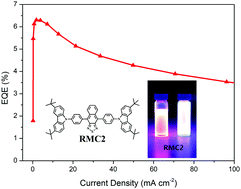Purely organic and saturated red emitters for a non-doped electroluminescent device with an EQE of 6.3% and low efficiency roll-off†
Abstract
Red organic light emitting diodes (OLEDs) based on purely organic emitters with high efficiency, good colour chromaticity coordinates and low efficiency roll-off features are in high demand for display and lighting applications. Additionally, to simplify the device fabrication processes, it is desirable to develop OLEDs with non-doped emission layers. In this work, three 2,1,3-naphthodiazole-based red emissive model compounds (RMCs) with tailored electron-donating structures were synthesized. In comparison with the orange emissive RMC1 and the near infrared emissive RMC3, RMC2 with a moderate electron donating ability demonstrates a pure red peak emission at 625 nm. Moreover, RMC2 shows high fluorescence quantum efficiency (Φf) in both diluted solution (0.76) and neat films (0.41). Non-doped saturated red OLEDs based on RMC2 with a maximum luminous efficiency of 5.3 cd A−1, a maximum external quantum efficiency (EQE) of 6.3% and good CIE coordinates of (0.64, 0.35) are demonstrated. In addition, the device shows a slight efficiency roll-off feature, displaying an EQE of 5.1% at a brightness of 1000 cd m−2.



 Please wait while we load your content...
Please wait while we load your content...